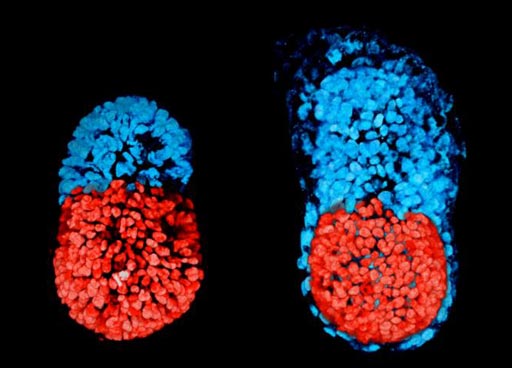Stem Cell Structure to Facilitate In Vitro Embryonic Studies
By LabMedica International staff writers
Posted on 16 Mar 2017
A biological construct that combines mouse embryonic stem cells and extra-embryonic trophoblast stem cells in a three-dimensional scaffold will allow in vitro studies of cellular interaction in a model that mimics a developing embryo.Posted on 16 Mar 2017
The development of a mammalian embryo requires intricate interactions between embryonic and extra-embryonic tissues to orchestrate and coordinate cellular differentiation with changes in developmental potential. In order to develop a model system to facilitate the study of embryonic development in vitro, investigators at the University of Cambridge combined genetically modified mouse embryonic stem cells (ESCs) and extra-embryonic trophoblast stem cells (TSCs) with specific inhibitors in a three-dimensional extracellular matrix scaffold.

Image: A photomicrograph showing stem cell-modeled mouse embryo at 96 hours (left); Mouse embryo cultured in vitro for 48 hours from the blastocyst stage (right). The red part is embryonic and the blue extra-embryonic (Photo courtesy of Sarah Harrison and Gaelle Recher, Zernicka-Goetz Laboratory, University of Cambridge).
The objective was to generate a structure that would that would mimic natural early stage embryos in which the ESCs cluster together at one end of the blastocyst. TSCs, which will form the placenta, are also found within the natural blastocyst as are primitive endoderm stem cells that will form the yolk sac.
The investigators reported in the March 2, 2017, online edition of the journal Science they were able to grow a structure capable of self-assembly whose development and architecture very closely resembled the natural embryo. Development of the embryo-like structure depended on molecular crosstalk involving Nodal signaling.
"Both the embryonic and extra-embryonic cells start to talk to each other and become organized into a structure that looks like and behaves like an embryo," said senior author Dr. Magdalena Zernicka-Goetz professor of physiology, development, and neuroscience, at the University of Cambridge. "It has anatomically correct regions that develop in the right place and at the right time."
"We knew that interactions between the different types of stem cell are important for development, but the striking thing that our new work illustrates is that this is a real partnership - these cells truly guide each other," said Dr. Zernicka-Goetz. "Without this partnership, the correct development of shape and form and the timely activity of key biological mechanisms do not take place properly. We think that it will be possible to mimic a lot of the developmental events occurring before 14 days using human embryonic and extra-embryonic stem cells using a similar approach to our technique using mouse stem cells. We are very optimistic that this will allow us to study key events of this critical stage of human development without actually having to work on embryos. Knowing how development normally occurs will allow us to understand why it so often goes wrong."













